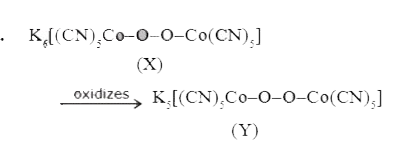
In both the complexes Co cation have t62ge0g configuration.
The B. E. of (O–O) in X & Y is
B. E. of (O – O) in y lt B. E of (O – O) in X
B. E. of (O – O) in X lt B. E. of (O – O) in Y
B. E. of (O – O) in X = B. E. of (O – O) in Y
can’t be compared
The correct Answer is:B
Step by step video, text & image solution for In both the complexes Co cation have t_(2g)^6 e_g^0 configuration. The B. E. of (O–O) in X & Y is by Chemistry experts to help you in doubts & scoring excellent marks in Class 12 exams.
Topper's Solved these Questions
- BOOK - MOTIONCHAPTER - COORDINATION COMPOUNDEXERCISE - EXERCISE -4 LEVEL I PREVIOUS YEAR JEE MAIN20videos
COORDINATION COMPOUND
- BOOK - MOTIONCHAPTER - COORDINATION COMPOUNDEXERCISE - EXERCISE-4 LEVEL-II PREVIOUS YEAR JEE ADVANCED37videos
COORDINATION COMPOUND
- BOOK - MOTIONCHAPTER - COORDINATION COMPOUNDEXERCISE - EXERCISE-2 (LEVEL -II) MULTIPLE CORRECT JEE ADVANCED Match the Column10videos
COORDINATION COMPOUND
- BOOK - MOTIONCHAPTER - CLASSROOM PROBLEMS 1EXERCISE - THERMODYNAMICS17videos
CLASSROOM PROBLEMS 1
- BOOK - MOTIONCHAPTER - D-BLOCK ELEMENTS EXERCISE - Exercise IV Level-II9videos
D-BLOCK ELEMENTS
Similar Questions
Knowledge Check
- Question 1 - Select One
K6[(CN)5Co−O−O−Co(CN)5]oxidised−−−−→(X)K5[(CN)5Co−O−O−Co(CN)5](Y)
In both the complexes Co have t2g6eg0 configuration. The bond energy of (O−O)in X and Y is:Abond energy of (O−O) in Y< bond energy of (O−O) in X.Bbond energy of (O−O) in X< bond energy of (O−O) in Y.Cbond energy of (O−O) in X=bond energy of (O−O) in Y.Dbond energy of (O−O)in X and bond energy of (O−O) in y can't be comparable. - Question 2 - Select One
K6[(CN)5 Co−O−O−Co(CN)5](X)oxidizes−−−−→K5[(CN)5Co−O−O−Co(CN)5](Y)
In both the complexes Co have t206e∘g configuration.
The bond energy of (O−O) in X ans Y is :Abond energy of (O−O) in Y< bond energy of (O−O) in X.Bbond energy of (O−O) in X< bond energy of (O−O) in Y.Cbond energy of (O−O) in X= bond energy of (O−O) in Y.Dbond energy of (O−O) in X and bond energ of (O−O) in Y can't be comparable. - Question 3 - Select One
[(H2O)4Co(O2)2Co(H2O)4](SO4)2[X]reagent−−−−−−→[(H2O)4Co(O2)2Co(H2O)4](SO4) (I) (II)
In both the complex Co has t62geg0 configuration. Which option is incorrect ?AComplex (I) is ParamagneticBComplex (II) is DiamagneticC(X) is oxidising agentD(X) is reducing agent
Which of the following statements are incorrect ?
(1) Co+3 with strong field ligand forms high magnetic moment complex.
(2) For Co+3 if pairing energy(P)>Δo then the complex formed will have (t42g,(eg)2) configuration. ltbr> (3) For [Co(en)3]3+λabsorbed is less than λabsorbed for [CoF6]3–
(4) If Δo=18000cm–1 for Co+3 then with same ligands for it Δt=16000cm–1View SolutionA metal complex having composition has been isolated in two forms (X) and (Y). The form (X) reacts with to give a white precipitate readily soluble in aqueous ammonia, whereas (Y) gives a pale-yellow precipitate soluble in concentrated ammonia.
Choose the correct statement regarding the complex X and Y.
(i) Both complexes have same Van’t Hoff factor for same extent of dissociation
(ii) Both complexes have exactly same conductivity in H2O
(iii) In both the complexes is involved only to secondary valency
(iv) In both the complexes electronic configuration of t2g subshell is same.
The correct choice is :View SolutionIn [(H2O)4Co−(O−O)−Co(H2O)4]CL5 complex, Co has t62geg0 configuration, this complex is :
View SolutionIn [(H2O)4Co−(O−O)−Co(H2O)4]CL5 complex, Co has t62geg0 configuration, this complex is :
View SolutionAll the metal ions contain t62ge0g configuaration. Which of the following complex will be paramagnetic ?
View Solution

